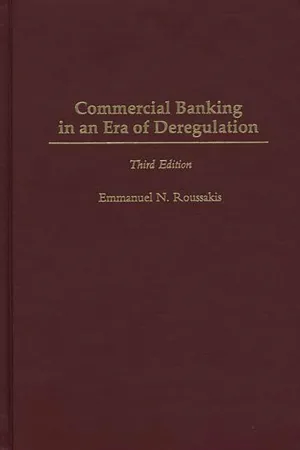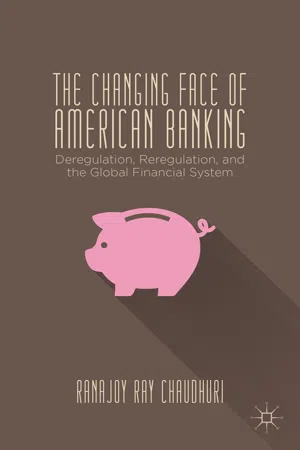Economics
Riegle Neal Interstate Banking Act
The Riegle-Neal Interstate Banking Act is a US federal law that allows banks to acquire other banks across state lines. It was enacted in 1994 to remove barriers to interstate banking and promote competition in the banking industry. The law also established a framework for regulatory oversight of interstate banking activities.
Written by Perlego with AI-assistance
Related key terms
1 of 5
3 Key excerpts on "Riegle Neal Interstate Banking Act"
- No longer available |Learn more
- Stephan Leimberg, Robert J. Doyle, Michael S. Jackson, Martin J Satinsky(Authors)
- 2019(Publication Date)
- The National Underwriter Company(Publisher)
The need for the Douglas Amendment grew from the concern that bank holding companies were evading the McFadden Act and state branching laws by acquiring numerous subsidiary banks in various states, and then operating these banks as if they were branches. The development of these interstate bank networks was a significant factor leading to Congress’ passage of the Bank Holding Company Act of 1956. Senator Douglas emphasized that a primary purpose of his amendment was “to prevent an undue concentration of banking and financial power, and instead keep the private control of credit diffused as much as possible.”The Riegle-Neal Interstate Banking and Branching Efficiency Act of 1994 repealed the Douglas Amendment. On September 29, 1995, federal law allowed full nationwide banking across the country, regardless of state law. Another provision of the Riegle-Neal Act allows affiliate banks within bank holding companies to effectively act as branches for each other, accepting deposits, collecting payments, and providing other customer services.Interstate banking has resulted in increased consolidation and concentration in the banking industry. While the United States had 14,399 banks in 1940, the country has fewer than 6,500 banks in December 2014. However, while consolidation among banks has certainly been the trend, the number of branches in the U.S. has steadily increased. In other words, consumers have more banking outlets than ever in our country’s history.Interstate BranchingInterstate branching means that a single bank may operate branches in more than one state without requiring separate capital and corporate structures for each state, that is, without the holding company organizational structure. The state of New York approved the first interstate branching statute in 1992. This law set several requirements and conditions on New York branches of out-of-state banks. It also required reciprocity; that New York banks were allowed to branch into the home states of banks that branch into New York. Other states passed similar laws.The 1994 Riegle-Neal Interstate Banking and Branching Efficiency Act allowed national banks to operate branches across state lines after June 1, 1997. This federal law allows branching through acquisition only, which means that a bank must acquire another bank and merge the two structures in order to operate branches across state lines. - eBook - PDF
- Emmanuel Roussakis(Author)
- 1997(Publication Date)
- Praeger(Publisher)
Thus, thrift institutions gained interstate branching rights five years ahead of banking organizations. Deregulation of interstate banking gave important impetus to the growth of bank holding companies as a vehicle for banking organizations to expand geo- graphically. Thus, to operate across state lines many banks formed holding com- panies and purchased banks in other states. Although this approach moved the country toward nationwide banking, for the expansion-minded banking organi- zations it entailed costly duplication of capital and management. In 1994, to reduce these costs and offer consumers greater access to banking services across state borders, Congress passed the Riegle-Neal Interstate Banking and Branching Efficiency Act. Important provisions of this act are listed in Table 3.1. This law authorized a bank holding company in a safe and sound condition (i.e., ade- quately capitalized and adequately managed) and with a favorable community reinvestment record to acquire a bank in any state within a year from its en- actment. For the transaction to be approved, however, the resulting institution must not control more than 30 percent of the deposits in the state or more than 10 percent of nationwide deposits. Beginning June 1, 1997, bank holding companies may consolidate their in- terstate banks into a branch network, and freestanding banks may branch inter- state by merging with another bank across state lines. Such mergers would be *Savings and loan associations and mutual savings banks are designated as thrift institutions. Table 3.1 Key Provisions of the Riegle-Neal Interstate Banking and Branching Efficiency Act of 1994 The Banking Industry in Transition 47 subject to the same safety and soundness, community reinvestment, and con- centration requirements stated above. States were given until June 1, 1997 to decide. They were allowed to prohibit (opt out of) interstate branching by merger before June 1, 1997, or to authorize it earlier (opt in). - eBook - PDF
The Changing Face of American Banking
Deregulation, Reregulation, and the Global Financial System
- Ranajoy Ray Chaudhuri(Author)
- 2016(Publication Date)
- Palgrave Macmillan(Publisher)
Once the removal of these restrictions enabled them to achieve their optimal scale, further deregulation was unlikely to lead to additional contraction. The Riegle-Neal Act of 1994 came into effect on September 29, 1995, and invalidated the laws in 36 states that only allowed interstate banking on a reciprocal or regional basis. McLaughlin (1995) suggests that banking reforms will lead to faster consolidation of the banking industry in the United States, but although there has been rapid consolidation within state 190 ● The Changing Face of American Banking borders, the changes across state borders will be incremental and localized and will not lead to nationwide banking very soon. 31 This consolidation takes place through the bank holding companies’ conversion of existing and acquired bank subsidiaries into branches. A number of studies document the positive impact of banking deregulation in the United States. Schranz (1993) examines the impact of takeovers on firm value in the context of the banking sector and finds that publicly traded banks in states that make takeovers easier are more profitable. 32 Alternative mechanisms to maximize firm value, like concentration of equity ownership and management ownership of stock, are observed in states that have restrictions on takeovers. Berger, Kashyap, and Scalise (1995) find that the post-deregulation banking sector in the United States is characterized by a sharp fall in the number of banks and a sharp rise in the number of bank failures, off-balance-sheet activities, equity capital ratios, foreign bank lending to U.S. corporations, and the adop- tion of ATMs. 33 Additionally, lending to both small and large businesses fell in the first half of the nineties, whereas lending to medium-sized borrowers roughly stayed constant.
Index pages curate the most relevant extracts from our library of academic textbooks. They’ve been created using an in-house natural language model (NLM), each adding context and meaning to key research topics.


